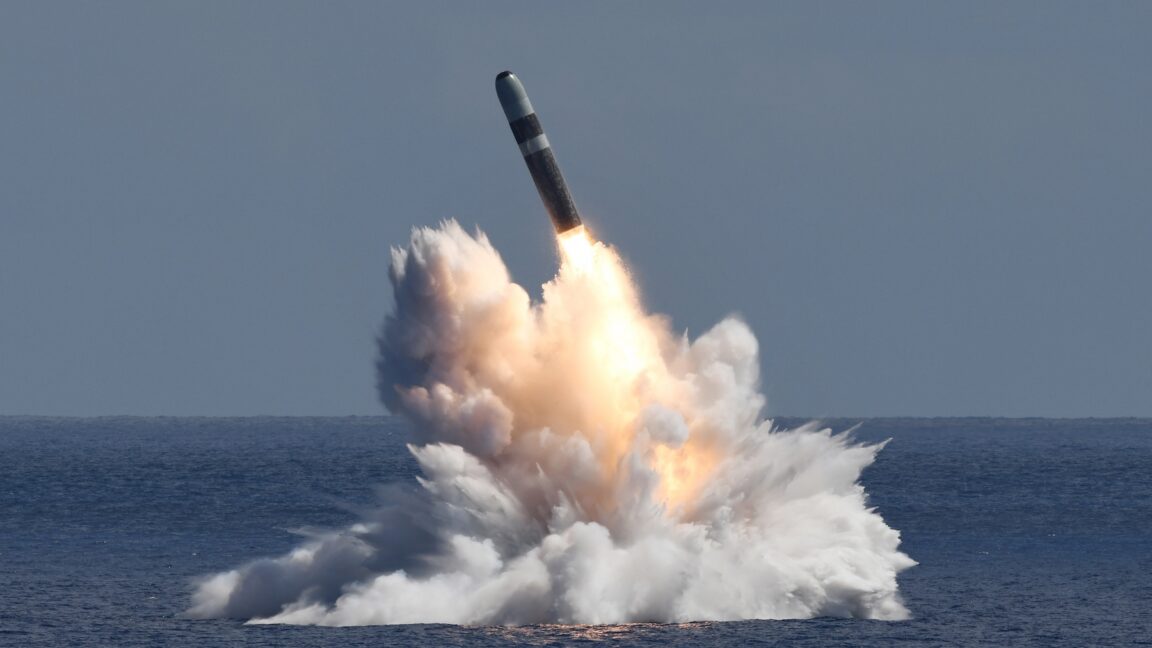
Welcome to Edition 8.12 of the Rocket Report! We often hear from satellite operators—from the military to venture-backed startups—about their appetite for more launch capacity. With so many rocket launches happening around the world, some might want to dismiss these statements as a corporate plea for more competition, and therefore lower prices. SpaceX is on pace to launch more than 150 times this year. China could end the year with more than 70 orbital launches. These are staggering numbers compared to global launch rates just a few years ago. But I’m convinced there’s room for more alternatives for reliable (and reusable) rockets. All of the world’s planned mega-constellations will need immense launch capacity just to get off the ground, and if successful, they’ll go into regular replacement and replenishment cycles. Throw in the still-undefined Golden Dome missile shield and many nations’ desire for a sovereign launch capability, and it’s easy to see the demand curve going up.
As always, we welcome reader submissions. If you don’t want to miss an issue, please subscribe using the box below (the form will not appear on AMP-enabled versions of the site). Each report will include information on small-, medium-, and heavy-lift rockets, as well as a quick look ahead at the next three launches on the calendar.
Sharp words from Astra’s Chris Kemp. Chris Kemp, the chief executive officer of Astra, apparently didn’t get the memo about playing nice with his competitors in the launch business. Kemp made some spicy remarks at the Berkeley Space Symposium 2025 earlier this month, billed as the largest undergraduate aerospace event at the university (see video of the talk). During the speech, Kemp periodically deviated from building up Astra to hurling insults at several of his competitors in the launch industry, Ars reports. To be fair to Kemp, some of his criticisms are not without a kernel of truth. But they are uncharacteristically rough all the same, especially given Astra’s uneven-at-best launch record and financial solvency to date.
Wait, what?! … Kemp is generally laudatory in his comments about SpaceX, but his most crass statement took aim at the quality of life of SpaceX employees at Starbase, Texas. He said life at Astra is “more fun than SpaceX because we’re not on the border of Mexico where they’ll chop your head off if you accidentally take a left turn.” For the record, no SpaceX employees have been beheaded. “And you don’t have to live in a trailer. And we don’t make you work six and a half days a week, 12 hours a day.” Kemp also accused Firefly Aerospace of sending Astra “garbage” rocket engines as part of the companies’ partnership on propulsion for Astra’s next-generation rocket.
The Ars Technica Rocket Report
The easiest way to keep up with Eric Berger’s and Stephen Clark’s reporting on all things space is to sign up for our newsletter. We’ll collect their stories and deliver them straight to your inbox.
Sign Me Up!
A step forward for Europe’s reusable rocket program. No one could accuse the European Space Agency and its various contractors of moving swiftly when it comes to the development of reusable rockets. However, it appears that Europe is finally making some credible progress, Ars reports. Last week, the France-based ArianeGroup aerospace company announced that it completed the integration of the Themis vehicle, a prototype rocket that will test various landing technologies, on a launch pad in Sweden. Low-altitude hop tests, a precursor for developing a rocket’s first stage that can vertically land after an orbital launch, could start late this year or early next.
Hopping into the future … “This milestone marks the beginning of the ‘combined tests,’ during which the interface between Themis and the launch pad’s mechanical, electrical, and fluid systems will be thoroughly trialed, with the aim of completing a test under cryogenic conditions,” ArianeGroup said. This particular rocket will likely undergo only short hops, initially about 100 meters. A follow-up vehicle, Themis T1E, is intended to fly medium-altitude tests at a later date. Some of the learnings from these prototypes will feed into a smaller, reusable rocket intended to lift 500 kilograms to low-Earth orbit. This is under development by MaiaSpace, a subsidiary of ArianeGroup. Eventually, the European Space Agency would like to use technology developed as part of Themis to develop a new line of reusable rockets that will succeed the Ariane 6 rocket.
Navy conducts Trident missile drills. The US Navy carried out four scheduled missile tests of a nuclear-capable weapons system off the coast of Florida within the last week, Defense News reports. The service’s Strategic Systems Programs conducted flights of unarmed Trident II D5 Life Extension missiles from a submerged Ohio-class ballistic missile submarine from September 17 to September 21 as part of an ongoing scheduled event meant to test the reliability of the system. “The missile tests were not conducted in response to any ongoing world events,” a Navy release said.
Secret with high visibility … The Navy periodically performs these Trident missile tests off the coasts of Florida and California, taking advantage of support infrastructure and range support from the two busiest US spaceports. The military doesn’t announce the exact timing of the tests, but warnings issued for pilots to stay out of the area give a general idea of when they might occur. One of the launch events Sunday was visible from Puerto Rico, illuminating the night sky in photos published on social media. The missiles fell in the Atlantic Ocean as intended, the Navy said. The Trident II D5 missiles were developed in the 1980s and are expected to remain in service on the Navy’s ballistic missile submarines into the 2040s. The Trident system is one leg of the US military’s nuclear triad, alongside land-based Minuteman ballistic missiles and nuclear-capable strategic bombers. (submitted by EllPeaTea)
Firefly plans for Alpha’s return to flight. Firefly Aerospace expects to resume Alpha launches in the “coming weeks,” with two flights planned before the end of the year, Space News reports. These will be the first flights of Firefly’s one-ton-class Alpha rocket since a failure in April destroyed a Lockheed Martin tech demo satellite after liftoff from California. In a quarterly earnings call, Firefly shared a photo showing its next two Alpha rockets awaiting shipment from the company’s Texas factory.
Righting the ship … These next two launches really need to go well for Firefly. The Alpha rocket has, at best, a mixed record with only two fully successful flights in six attempts. Two other missions put their payloads into off-target orbits, and two Alpha launches failed to reach orbit at all. Firefly went public on the NASDAQ stock exchange last month, raising nearly $900 million in the initial public offering to help fund the company’s future programs, namely the medium-lift Eclipse rocket developed in partnership with Northrop Grumman. There’s a lot to like about Firefly. The company achieved the first fully successful landing of a commercial spacecraft on the Moon in March. NASA has selected Firefly for three more commercial landings on the Moon, and Firefly reported this week it has an agreement with an unnamed commercial customer for an additional dedicated mission. But the Alpha program hasn’t had the same level of success. We’ll see if Firefly can get the rocket on track soon. (submitted by EllPeaTea)
Avio wins contract to launch “extra-European” mission. Italian rocket builder Avio has signed a launch services agreement with US-based launch aggregator SpaceLaunch for a Vega C launch carrying an Earth observation satellite for an “extra-European institutional customer” in 2027, European Spaceflight reports. Avio announced that it had secured the launch contract on September 18. According to the company, the contract was awarded through an open international competition, with Vega C chosen for its “versatility and cost-effectiveness.” While Avio did not reveal the identity of the “extra-European” customer, it said that it would do so later this year.
Plenty of peculiarities … There are several questions to unpack here, and Andrew Parsonson of European Spaceflight goes through them all. Presumably, extra-European means the customer is based outside of Europe. Avio’s statement suggests we’ll find out the answer to that question soon. Details about the US-based launch broker SpaceLaunch are harder to find. SpaceLaunch appears to have been founded in January 2025 by two former Firefly Aerospace employees with a combined 40 years of experience in the industry. On its website, the company claims to provide end-to-end satellite launch integration, mission management, and launch procurement services with a “portfolio of launch vehicle capacity around the globe.” SpaceLaunch boasts it has supported the launch of more than 150 satellites on 12 different launch vehicles. However, according to public records, it does not appear that the company itself has supported a single launch. Instead, the claim seems to credit SpaceLaunch with launches that were actually carried out during the two founders’ previous tenures at Spaceflight, Firefly Aerospace, Northrop Grumman, and the US Air Force. (submitted by EllPeaTea)
Falcon 9 launches three missions for NASA and NOAA. Scientists loaded three missions worth nearly $1.6 billion on a SpaceX Falcon 9 rocket for launch Wednesday, toward an orbit nearly a million miles from Earth, to measure the supersonic stream of charged particles emanating from the Sun, Ars reports. One of the missions, from the National Oceanic and Atmospheric Administration (NOAA), will beam back real-time observations of the solar wind to provide advance warning of geomagnetic storms that could affect power grids, radio communications, GPS navigation, air travel, and satellite operations. The other two missions come from NASA, with research objectives that include studying the boundary between the Solar System and interstellar space and observing the rarely seen outermost layer of our own planet’s atmosphere.
Immense value …All three spacecraft will operate in orbit around the L1 Lagrange point, a gravitational balance point located more than 900,000 miles (1.5 million kilometers) from Earth. Bundling these three missions onto the same rocket saved at least tens of millions of dollars in launch costs. Normally, they would have needed three different rockets. Rideshare missions to low-Earth orbit are becoming more common, but spacecraft departing for more distant destinations like the L1 Lagrange point are rare. Getting all three missions on the same launch required extensive planning, a stroke of luck, and fortuitous timing. “This is the ultimate cosmic carpool,” said Joe Westlake, director of NASA’s heliophysics division. “These three missions heading out to the Sun-Earth L1 point riding along together provide immense value for the American taxpayer.”
US officials concerned about China mastering reusable launch. SpaceX’s dominance in reusable rocketry is one of the most important advantages the United States has over China as competition between the two nations extends into space, US Space Force officials said Monday. But several Chinese companies are getting close to fielding their own reusable rockets, Ars reports. “It’s concerning how fast they’re going,” said Brig. Gen. Brian Sidari, the Space Force’s deputy chief of space operations for intelligence. “I’m concerned about when the Chinese figure out how to do reusable lift that allows them to put more capability on orbit at a quicker cadence than currently exists.”
By the numbers … China has used 14 different types of rockets on its 56 orbital-class missions this year, and none have flown more than 11 times. Eight US rocket types have cumulatively flown 145 times, with 122 of those using SpaceX’s workhorse Falcon 9. Without a reusable rocket, China must maintain more rocket companies to sustain a launch rate of just one-third to one-half that of the United States. This contrasts with the situation just four years ago, when China outpaced the United States in orbital rocket launches. The growth in US launches has been a direct result of SpaceX’s improvements to launch at a higher rate, an achievement primarily driven by the recovery and reuse of Falcon 9 boosters and payload fairings.
Atlas V launches more Kuiper satellites. Roughly an hour past sunrise Thursday, an Atlas V rocket from United Launch Alliance took flight from Cape Canaveral Space Force Station, Florida. Onboard the rocket, flying in its most powerful configuration, were the next 27 Project Kuiper broadband satellites from Amazon, Spaceflight Now reports. This is the third batch of production satellites launched by ULA and the fifth overall for the growing low-Earth orbit constellation. The Atlas V rocket released the 27 Kuiper satellites about 280 miles (450 kilometers) above Earth. The satellites will use onboard propulsion to boost themselves to their assigned orbit at 392 miles (630 kilometers).
Another Kuiper launch on tap … With this deployment, Amazon now has 129 satellites in orbit. This is a small fraction of the network’s planned total of 3,232 satellites, but Amazon has enjoyed a steep ramp-up in the Kuiper launch cadence as the company’s satellite assembly line in Kirkland, Washington, continues churning out spacecraft. Another 24 Kuiper satellites are slated to launch September 30 on a SpaceX Falcon 9 rocket, and Amazon has delivered enough satellites to Florida for an additional launch later this fall. (submitted by EllPeaTea)
German military will fly with Ariane 6. Airbus Defense and Space has awarded Arianespace a contract to launch a pair of SATCOMBw-3 communications satellites for the German Armed Forces, European Spaceflight reports. Airbus is the prime contractor for the nearly $2.5 billion (2.1 billion euro) SATCOMBw-3 program, which will take over from the two-satellite SATCOMBw-2 constellation currently providing secure communications for the German military. Arianespace announced Wednesday that it had been awarded the contract to launch the satellites aboard two Ariane 6 rockets. “By signing this new strategic contract for the German Armed Forces, Arianespace accomplishes its core mission of guaranteeing autonomous access to space for European sovereign satellites,” said Arianespace CEO David Cavaillolès.
Running home to Europe … The chief goal of the Ariane 6 program is to provide Europe with independent access to space, something many European governments see as a strategic requirement. Several European military, national security, and scientific satellites have launched on SpaceX Falcon 9 rockets in the last few years as officials waited for the debut of the Ariane 6 rocket. With three successful Ariane 6 flights now in the books, European customers seem to now have the confidence to commit to flying their satellites on Ariane 6. (submitted by EllPeaTea)
Artemis II launch targeted for February. NASA is pressing ahead with preparations for the first launch of humans beyond low-Earth orbit in more than five decades, and officials said Tuesday that the Artemis II mission could take flight early next year, Ars reports. Although work remains to be done, the space agency is now pushing toward a launch window that opens on February 5, 2026, officials said during a news conference on Tuesday at Johnson Space Center. The Artemis II mission represents a major step forward for NASA and seeks to send four astronauts—Reid Wiseman, Victor Glover, Christina Koch, and Jeremy Hansen—around the Moon and back. The 10-day mission will be the first time astronauts have left low-Earth orbit since the Apollo 17 mission in December 1972.
Orion named Integrity … The first astronauts set to fly to the Moon in more than 50 years will do so in Integrity, Ars reports. NASA’s Artemis II crew revealed Integrity as the name of their Orion spacecraft during a news conference on Wednesday at the Johnson Space Center in Houston. “We thought, as a crew, we need to name this spacecraft. We need to have a name for the Orion spacecraft that we’re going to ride this magical mission on,” said Wiseman, commander of the Artemis II mission.
FAA reveals new Starship trajectories. Sometime soon, perhaps next year, SpaceX will attempt to fly one of its enormous Starship rockets from low-Earth orbit back to its launch pad in South Texas. A successful return and catch at the launch tower would demonstrate a key capability underpinning Elon Musk’s hopes for a fully reusable rocket. In order for this to happen, SpaceX must overcome the tyranny of geography. A new document released by the Federal Aviation Administration shows the narrow corridors Starship will fly to space and back when SpaceX tries to recover them, Ars reports.
Flying over people … It was always evident that flying a Starship from low-Earth orbit back to Starbase would require the rocket to fly over Mexico and portions of South Texas. The rocket launches to the east over the Gulf of Mexico, so it must approach Starbase from the west when it comes in for a landing. The new maps show SpaceX will launch Starships to the southeast over the Gulf and the Caribbean Sea, and directly over Jamaica, or to the northeast over the Gulf and the Florida peninsula. On reentry, the ship will fly over Baja California and Mexico’s interior near the cities of Hermosillo and Chihuahua, each with a population of roughly a million people. The trajectory would bring Starship well north of the Monterrey metro area and its 5.3 million residents, then over the Rio Grande Valley near the Texas cities of McAllen and Brownsville.
New Glenn’s second flight at least a month away. The second launch of Blue Origin’s New Glenn rocket, carrying a NASA smallsat mission to Mars, is now expected in late October or early November, Space News reports. Tim Dunn, NASA’s senior launch director at Kennedy Space Center, provided an updated schedule for the second flight of New Glenn in comments after a NASA-sponsored launch on a Falcon 9 rocket Wednesday. Previously, the official schedule from NASA showed the launch date as no earlier than September 29.
No surprise … It was already apparent that this launch wouldn’t happen September 29. Blue Origin has test-fired the second stage for the upcoming flight of the New Glenn rocket but hasn’t rolled the first stage to the launch pad for its static fire. Seeing the rocket emerge from Blue’s factory in Florida will be an indication that the launch date is finally near. Blue Origin will launch NASA’s ESCAPADE mission, a pair of small satellites to study how the solar wind interacts with the Martian upper atmosphere.



